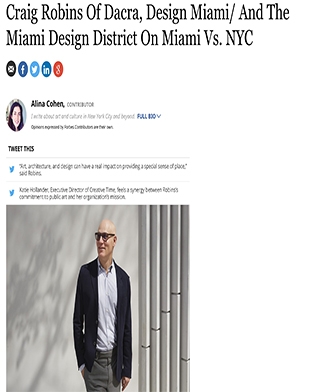

Craig Robins Of Dacra, Design Miami/ And The Miami Design District On Miami Vs. NYC
Alina CohenYour mental images upon hearing “Miami” and “New York City” are probably very different. Miami: tan, healthy-looking people in white swimsuits lying on a beach with an expensive car behind them. New York: jittery, pale people in black clothing, sitting on a subway bench, thinking about what they’re going to order on Seamless (full disclosure: this was the author about an hour before she started writing this article).
Regardless of how much natural Vitamin D their citizens receive, Miami and New York share a value in public art and design. Craig Robins, founder and CEO of the Miami-based real estate company Dacra, spoke to me this week about the cities’ approaches to both. A Miami native, Robins has devoted much of his career to developing the Miami Design District. Robins is also the Chairman of Design Miami/, an annual fair that runs concurrently with Art Basel Miami Beach. Tonight, Creative Time, a New York-based organization that commissions and presents public art, will honor Robins at their gala. When I spoke to him, Robins was still in Miami, preparing for his trip.
“A lot of the most interesting public art tends to be site-specific,” said Robins. “It doesn’t necessarily need to be the case, but a lot of interesting expression gets somewhat influenced by the location that it’s conceived for.” In Miami, he cites Richard Tuttle’s Splash, a mural at the Aqua condo complex; Zaha Hadid’s Elastika, an installation at the historical Moore Building; and John Baldessari’s Fun One, a façade for the City View Garage. The works feel distinctly “Miami”—Baldessari used an image of figures around a swimming pool, Tuttle also plays with an aquatic theme, and Hadid reinvigorated a building built in the 1920s by juxtaposing two elements of Miami design: art deco and something more futuristic. “Art, architecture, and design can have a real impact on providing a special sense of place,” said Robins.
Robins also spoke about what only Miami has brought to the worldwide art scene. “When you go back before 2002, when Art Basel Miami started, the idea of a global, cultural happening celebrating art for the whole city with so much frenetic creative and art-related activity didn’t really exist. Maybe the Venice Biennale. It wasn’t in this current model, and Miami kind of invented that. Of course, it could only have been inspired by the sophistication and style of cities like Paris, London, New York and the legacy of culture as an important ingredient in making the city.”
One New York public artwork inspired Robins in particular. He recalls Robert Irwin’s 1987 project at Wave Hill in the Bronx as “brilliantly done and so sophisticated…one of the greatest examples of public art that I’ve ever see.” Irwin, a pioneer of the “Light and Space” movement in the 1960s, is known especially for his site-conditional projects.
ORIGINAL SOURCE